SC Rheindorf Altach have gone through quite a turbulent spell over the last three years.
Having been promoted to the Austrian Bundesliga in 2014, the side finished third at the first time of asking under Damir Canadi and qualified for the UEFA Europa League which was the club’s debut in European competition.
Unfortunately, Altach didn’t manage to beat Belenenses in the Europa League playoff round and so bowed out of the competition before the group phase, but getting to that stage in the first place was still an amazing feat by Canadi and his players.
By Christmas 2016, the Austrian minnows from Vorarlberg were top of the Bundesliga. Canadi’s incredible work earned him a move to Rapid Wien and so began the team’s downfall.
Altach ended the campaign in fourth, qualifying for the Europa League’s preliminary rounds once again, which doesn’t seem too bad, but the team had the second-worst record in the division in the second half of the season after Canadi’s mid-season departure.
The team declined further and further and even Canadi returned to the helm for an unsuccessful spell where it was alleged that players conspired behind the legendary Altach coach’s back to change the tactics before a game.
Canadi’s successor Ludovic Magnin guided the team to safety by one point before leaving just a few days later. His replacement was certainly an exciting one, a household name, a rather inexperienced coach, but a World Cup winner.
His name is Miroslav Klose. In fact, Klose is not just a World Cup winner, he is the top goalscorer in the history of the competition and the record scorer for the German national team.
Taking charge of his first side in the men’s game, after spells as the assistant manager with Germany and Bayern Munich, as well as being the head coach of Bayern’s U17s, let’s take a look at the tactics used by the German great in this tactical analysis piece, focusing on the areas of weakness in Rheindorf Altach‘s setup.
Preferred formations
At the beginning of his tenure, Klose’s preference regarding his formation choice was a 4-2-3-1.
Rheindorf Altach got off to a solid start with this conventional structure, the same formation that Germany used under Hansi Flick during the 2020/21 Bundesliga-winning season in which Klose was the manager’s number two.
It was also the preferred formation of Joachim Low, the former Germany national team boss with whom Klose played under for ten years before moving onto his coaching staff as the assistant manager.
In the opening four games, Altach managed to beat TWL Elektra in the Austria Cup, draw 2-2 with Wolfsberger AC in the league and then beat Austria Wien in the Bundesliga too in what was a magnificent victory for the side.
Unfortunately, it was after this game that results quickly nose-dived as SCR Altach plummeted towards the bottom of the table within a matter of weeks. Now, Klose’s men are sitting third last, four points from Haltberg at the foot of the board.
Klose has been forced to change formation since after numerous failed experiments with his favoured 4-2-3-1. In recent weeks, the 3-4-3 has been the manager’s go-to as well as the 3-5-2 but the team’s shape now depends on the opposition at hand.
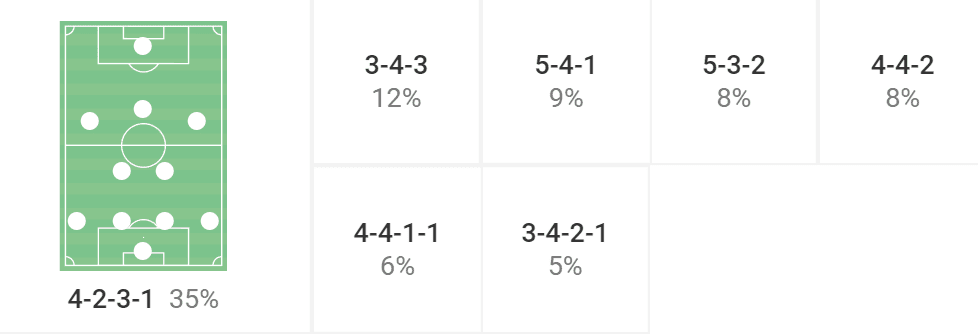
The team are really struggling under Klose. The manager has integrated a highly direct style of football, focused around playing long balls to the side’s gargantuan target man Atdhe Nuhiu, winning the second balls, plenty of crosses, and being pragmatic out of possession.
So far, Rheindorf Altach’s pizza plot makes for such terrifying reading that Stephen King and Raymond Chandler couldn’t concoct such a horrific composition.
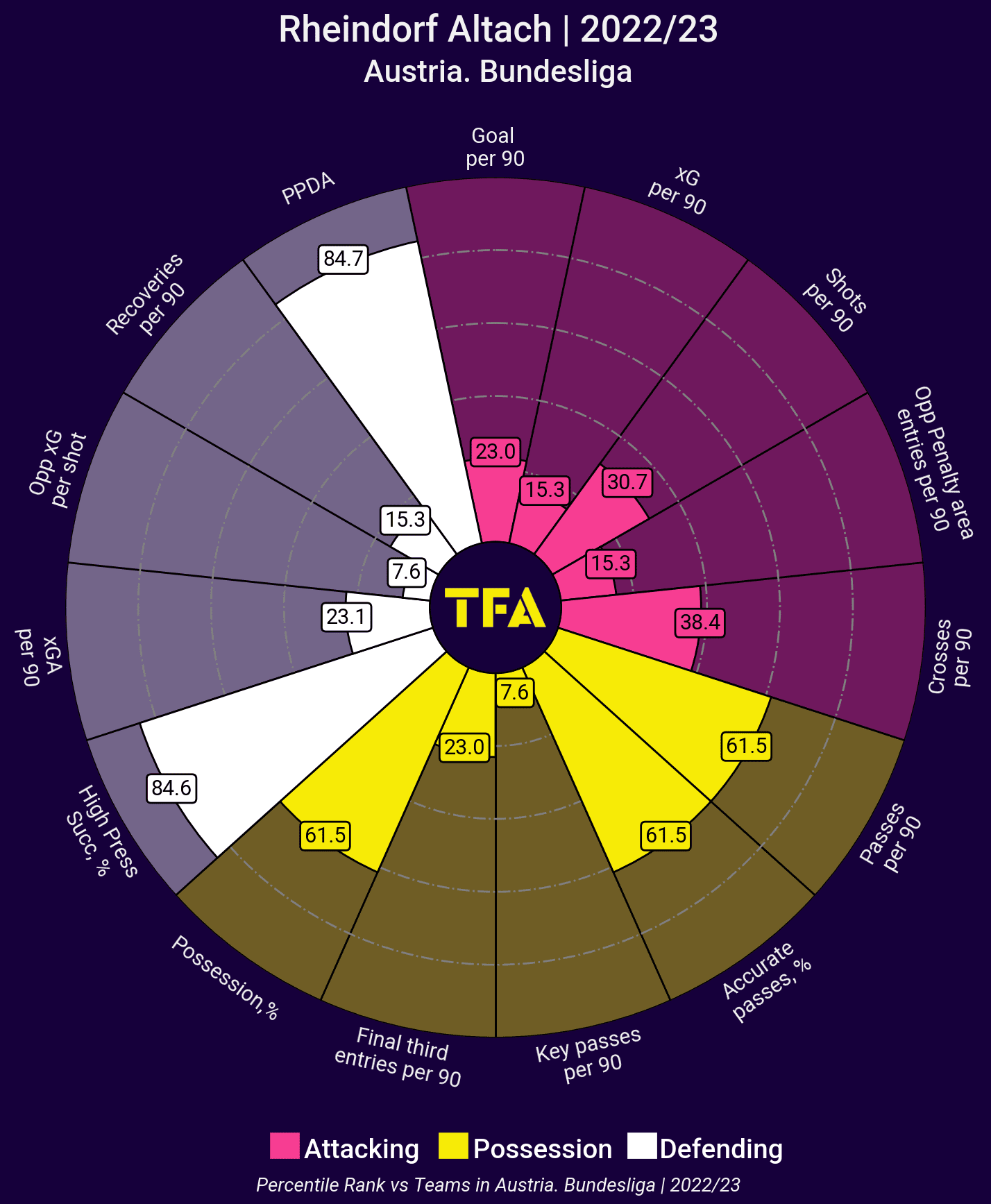
Rheindorf Altach have scored the third-lowest number of goals as well as conceding the joint-highest amount in the Bundesliga.
As the pizza chart shows, SCR Altach do press high up the pitch, as shown by their high pressing success rate as well as Passes allowed Per Defensive Actions (PPDA) ranking but their extremely low rating in almost all other metrics tells the tale of an abysmal team.
Are things as bad as the data tells us? Let’s find out in this analysis of Klose’s tactics at the Stadion Schnabelholz.
Pressing high
Under Klose, Rheindorf Altach press really high up the pitch. The World Cup winner is keen for his players to be actively involved in the final third out of possession to win the ball as close to their own goal as possible, potentially forcing turnovers which lead to excellent goalscoring opportunities.
Pressing in the opposition’s half is arguably SCR Altach’s most effective component of their tactical set-up as we saw in the pizza chart from the previous section.
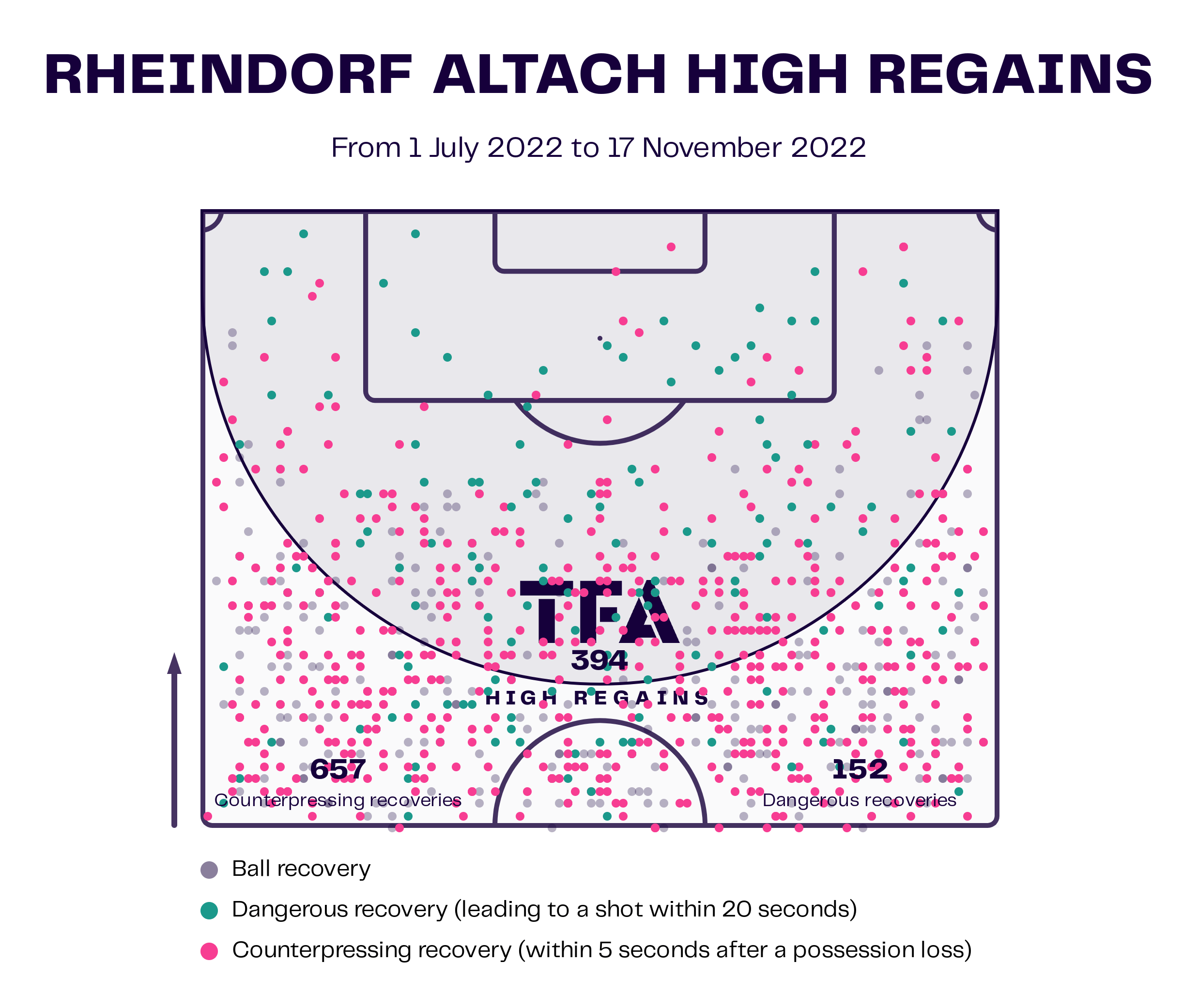
Klose’s side are particularly effective at counterpressing upon losing the ball and have registered 657 counterpressing recoveries this season so far in all competitions.
Furthermore, Rheindorf Altach are boasting 395 high regains as well as 152 dangerous recoveries, proving that they can pose a threat to teams who are trying to play out from the back.
When the team are pressing in the opponent’s third, Klose instructs his players to do so in a structured manner, maintaining their base shape. Particularly in recent games, this has been a 3-4-3, falling into a 5-2-3/5-4-1 out of possession.
SCR Altach press with a front three while the two central midfielders stay close behind them, marking their opposite numbers in case the forward line’s pressure is broken.
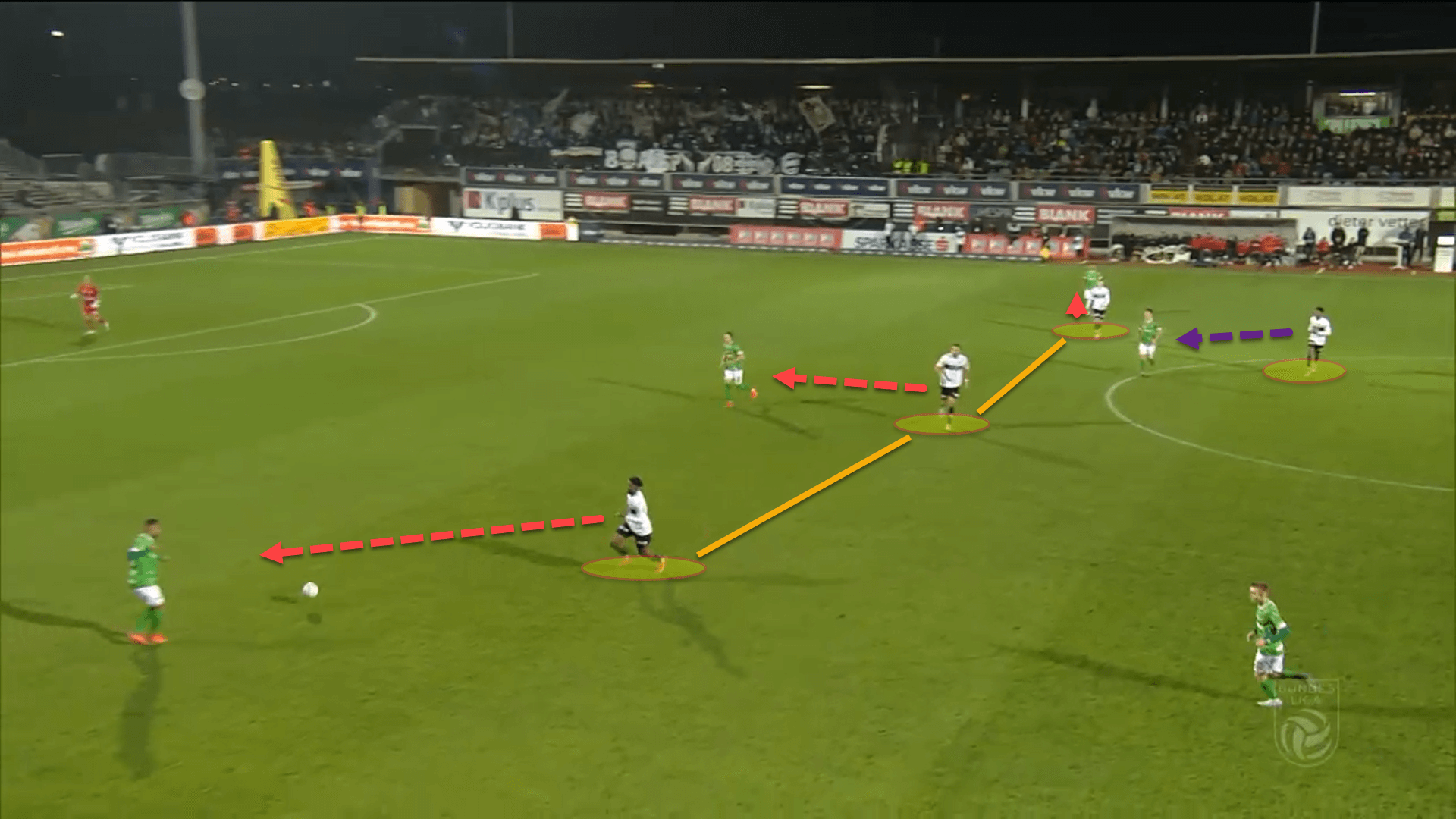
Here, against Austria Lustenau in the team’s most recent Bundesliga outing before the World Cup break, Klose’s side are pressing with their front three against the opposition’s back three, matching up perfectly.
Meanwhile, SCR Altach’s double-pivot were man-marking the deepest midfielders in Lustenau’s 3-5-2.
Rheindorf Altach’s pressing worked for the most part, although not as much as in recent games.
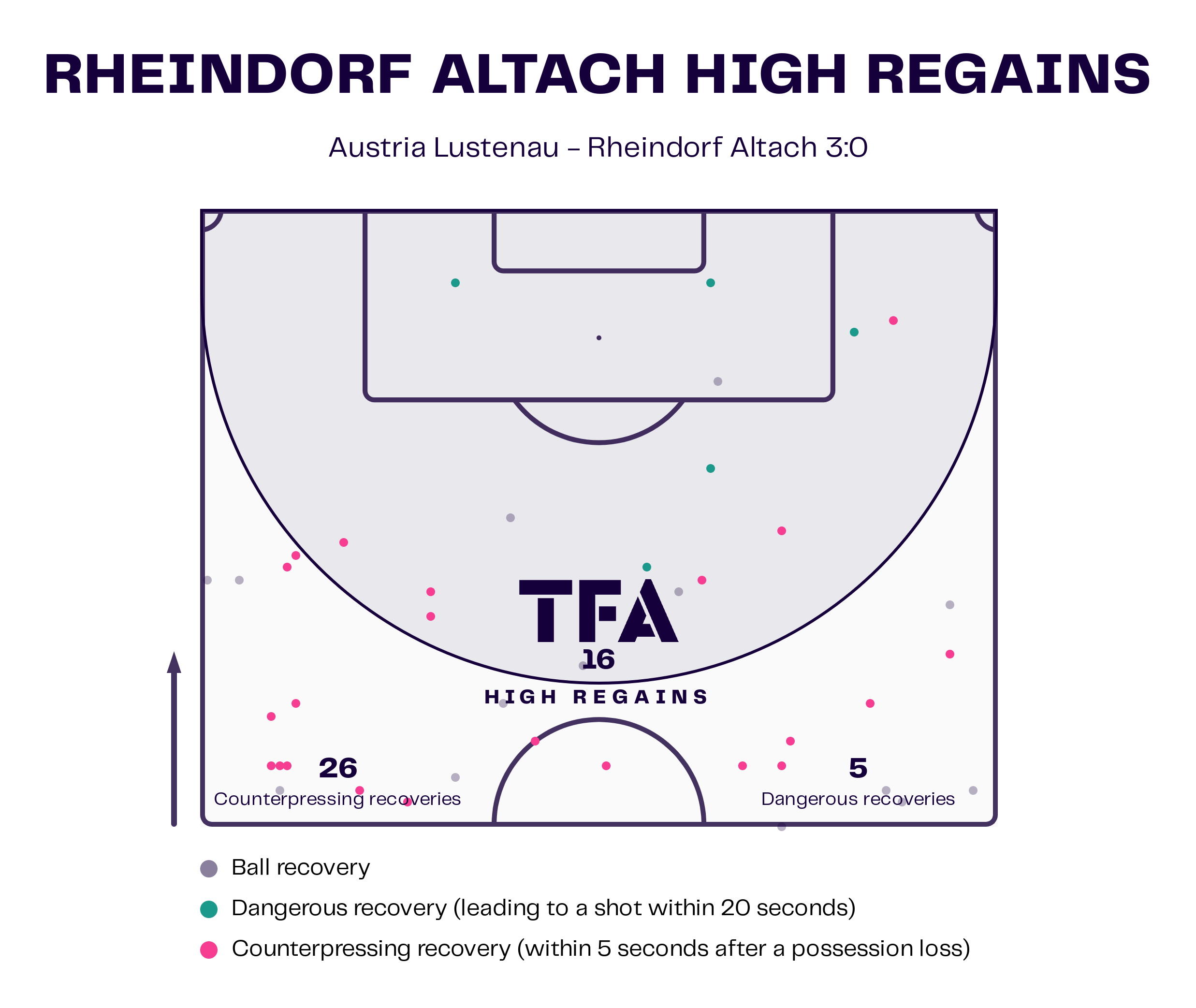
Nonetheless, there was a noticeable breakdown in the pressing structure throughout the match. One of the reasons for this was that Lustenau had positioned their wingbacks really high during the attacking phases, pinning back SCR Altach’s wingbacks.
This meant that Klose’s side were unable to push their wingbacks forward to join in the pressing. As a result, the Austrian minnows’ shape was a 5-2-3 which is far from ideal, pressing with merely a front three and two supporting players behind them with no help from the backline.
As Rheindorf Altach had done well to ensure that no passes were played behind their forward line, Lustenau’s midfielders would drift wide where they could receive unscathed.
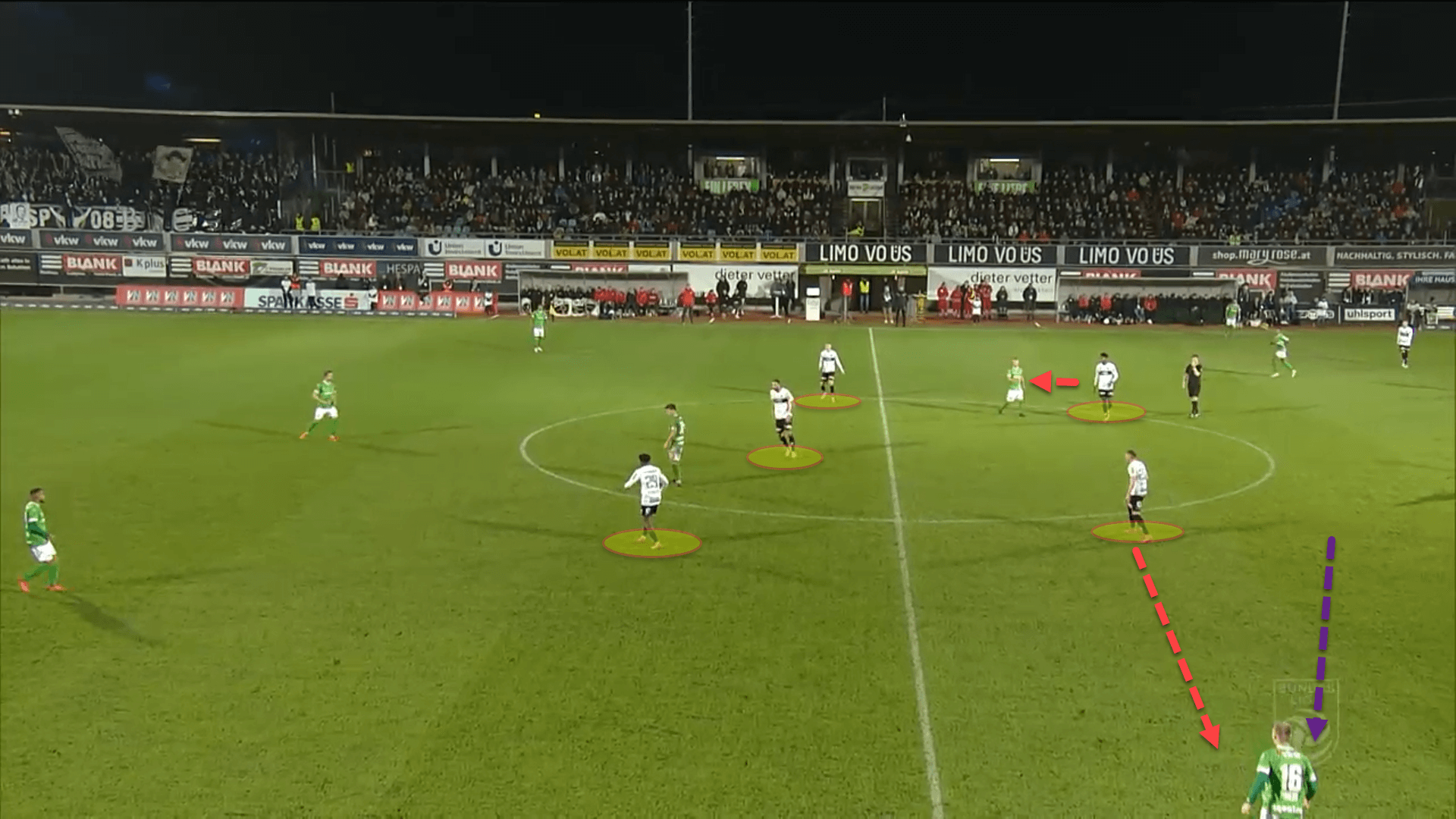
Here, Lustenau’s right central midfielder (number 16) has drifted out to the right in acres of space to receive the ball from the backline.
Since SCR Altach’s wingback on that side is pinned by his opposite number, one of the side’s central midfielders were forced to shift across to press him, leaving the team severely outnumbered in the middle of the park.
Ball progression from the first third to the Rheindorf Altach’s half of the pitch was relatively simple for Lustenau in this match and there were numerous lapses in the team’s pressing structure in the 3-0 hammering.
Poor low-block defending
Rheindorf Altach are not a team that are dominant in possession. Klose prefers his players to be vertical with their passing and rather direct to the forward line which will be analysed in greater detail later in this piece.
The manager has shown a reliance on his side being pragmatic out of possession, ceding the ball to the opposition and trying to prevent them from creating as many opportunities as possible.
Unfortunately, relying on a defence that has conceded the joint-most amount of goals in the Austrian Bundesliga so far is like expecting a table to stand up on its own without legs.
As Klose deploys a 3-4-3 formation, or sometimes even a 3-5-2, the structure drops into a 5-4-1/5-3-2 during the low block phase.
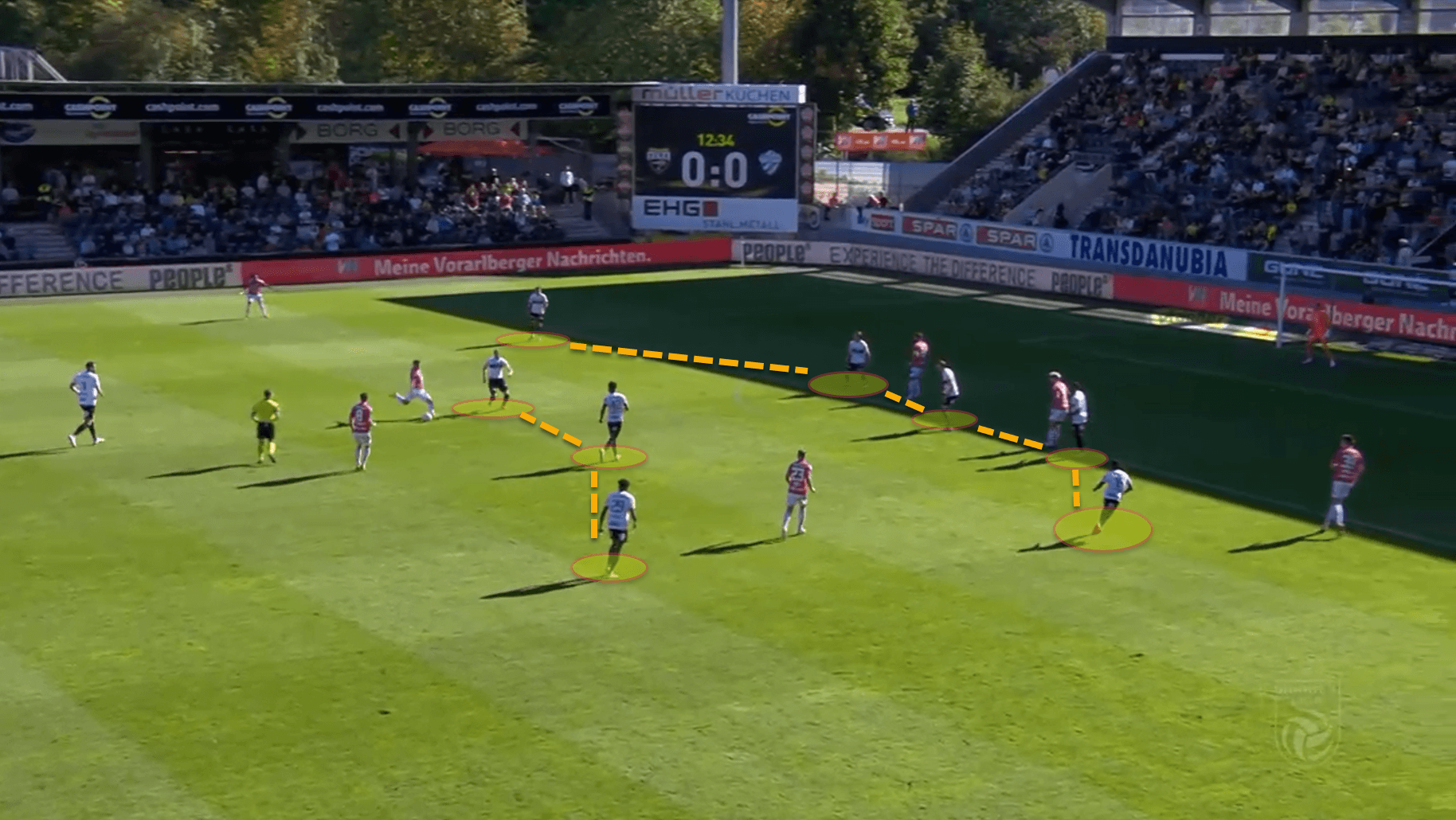
Under Klose, the average line of engagement and the height of the defensive line is roughly between the halfway line and Rheindorf Altach’s own penalty area, showing just how deep the team drop at times to defend their own box.
SCR Altach’s players aren’t the quickest and so having a relatively deep defensive line ensures that the centre-backs are not caught from balls over the top.
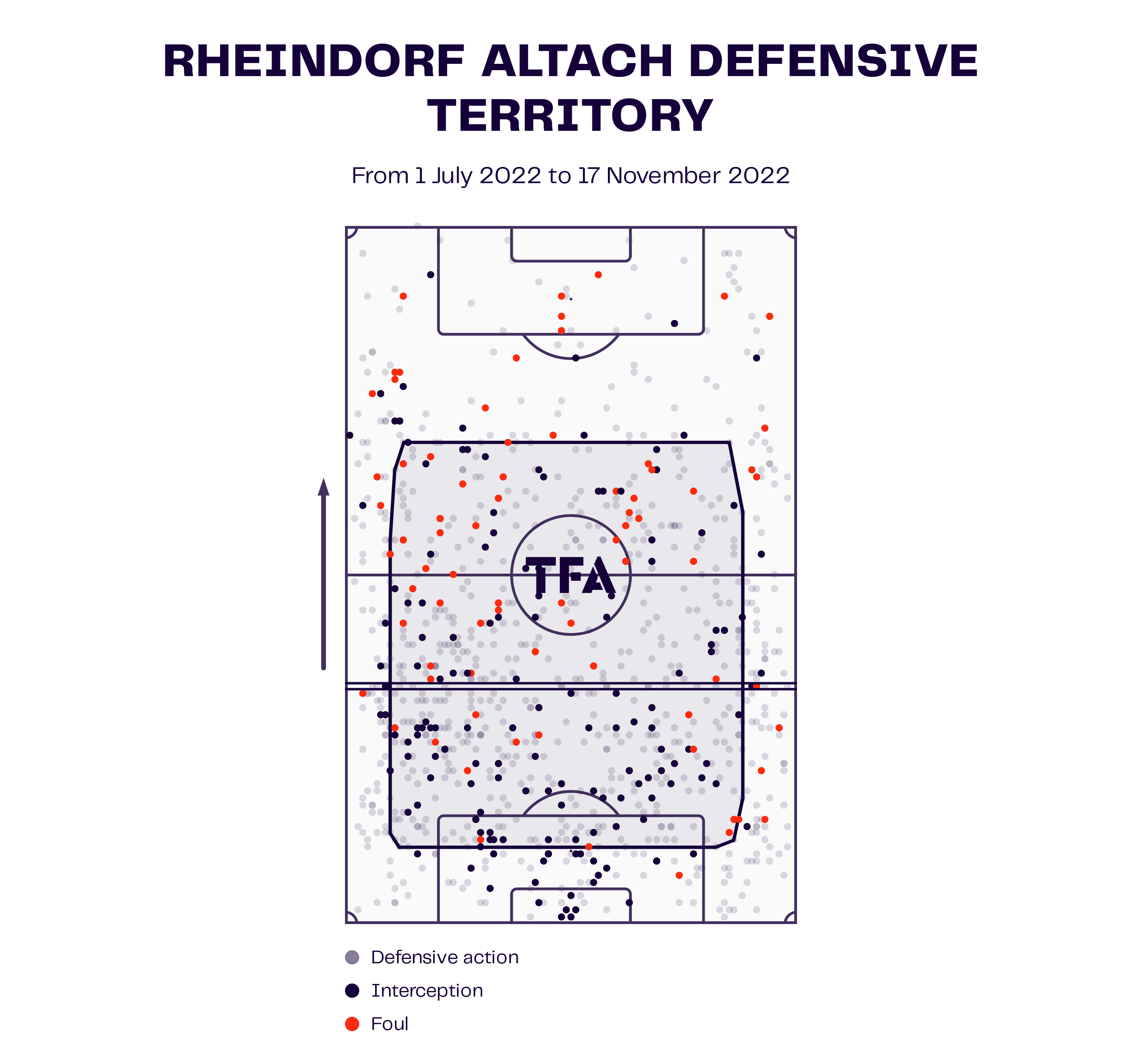
The issue with the team’s defending has been the worrying lack of concentration at the back. It can be far too easy for the opposition to get in behind, especially down the flanks, and when they do, the defending in and around the penalty area is a woeful sight to behold.
This doesn’t sound overly tactical, and it doesn’t need to be. Structural issues are not the only reason why teams concede a goal and from observing SCR Altach’s games this season, the team concede an awful number of goals from similar situations.
Regularly, the attacking side will get in behind down the flanks and look to cut the ball back across the byline. Ball watching, Klose’s players tend to get fooled by the trajectory of the ball and it’s far too late for them to step out to prevent a shot from the opponent.
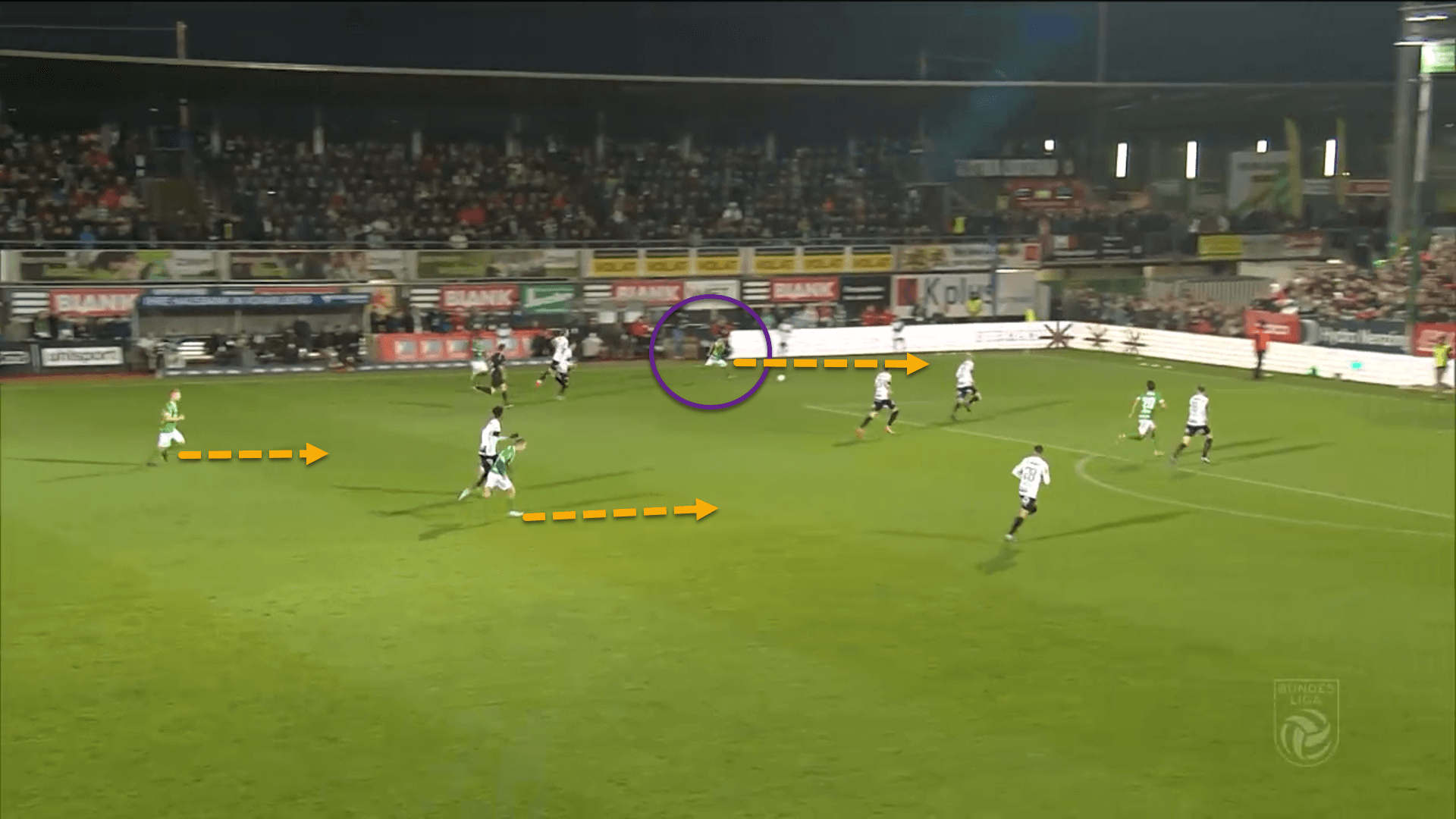
Here, for instance, Austria Lustenau have broken the side’s defensive line down the left. The wide player gets the ball near the byline which causes Altach’s players to drop as deep as possible, watching only the ball and failing to acknowledge the opponent’s midfielders making late runs into the area.
The ball is cut back to the edge of the 18-yard box. Klose’s men are too deep to be able to push out and close down the receiver, allowing him to smash home a beautiful finish on his left foot to open the scoring.
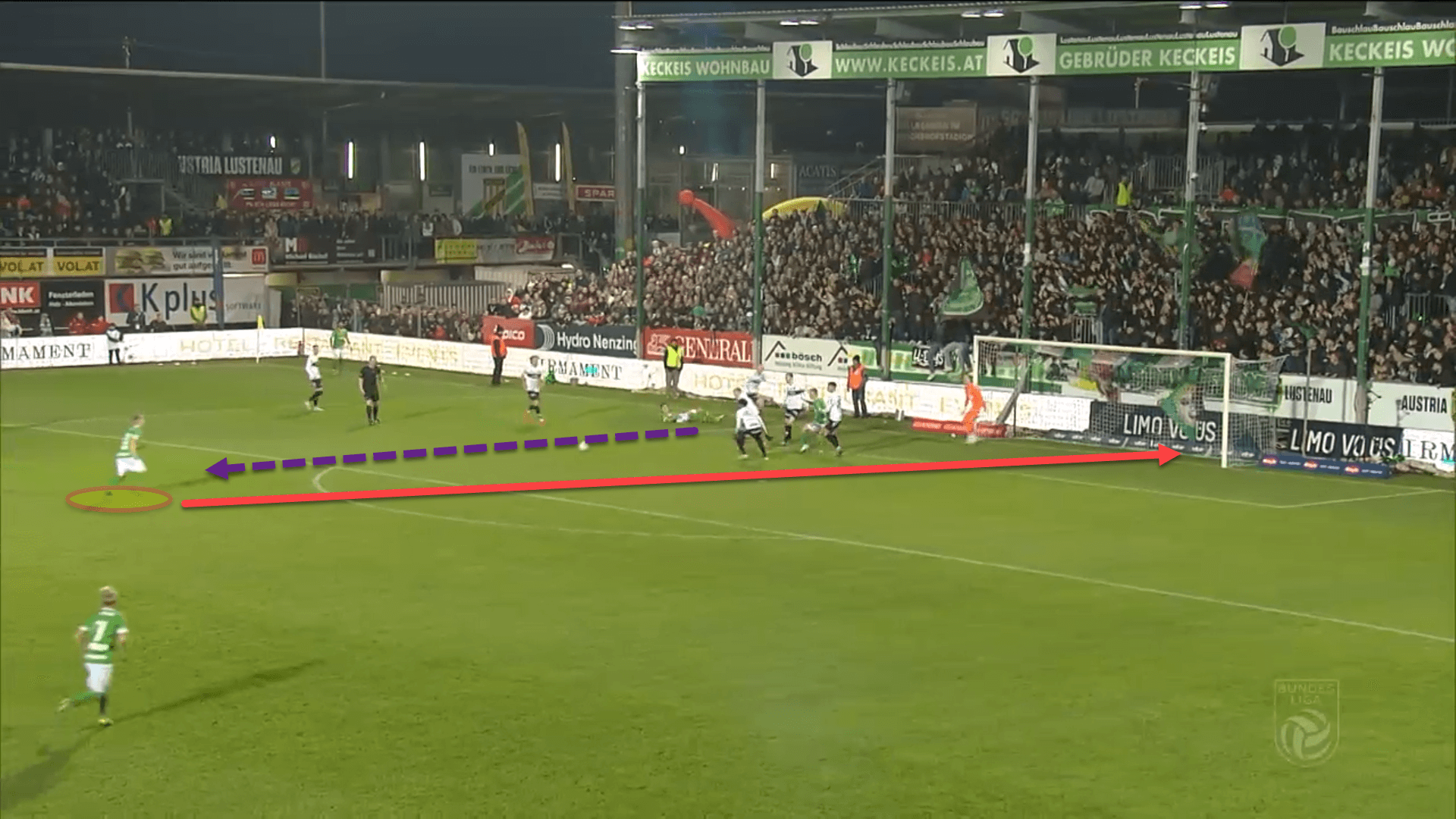
Furthermore, the complete detachment from the midfield in this example is worrying. Rheindorf Altach need to be more coordinated when defending in their own third, ensuring that there is adequate cover to pick up markers in the box, stop crosses into the area, and stop players who are making late runs from deep.
Pumping it long
For football purists, watching SCR Altach isn’t for the faint-hearted. Klose’s side don’t play beautiful passing football, relying instead on long balls to the number ‘9’ and high turnovers of possession with which they can transition towards the goal to score.
The team do set up to play short though, as most teams in the modern game do. In the build-up phase, the Austrian side use a 5-2 structure when attempting to play out from the back, keeping the wingbacks low to receive from the centre-backs while the midfielders screen the space behind the opposition’s first line of pressure.
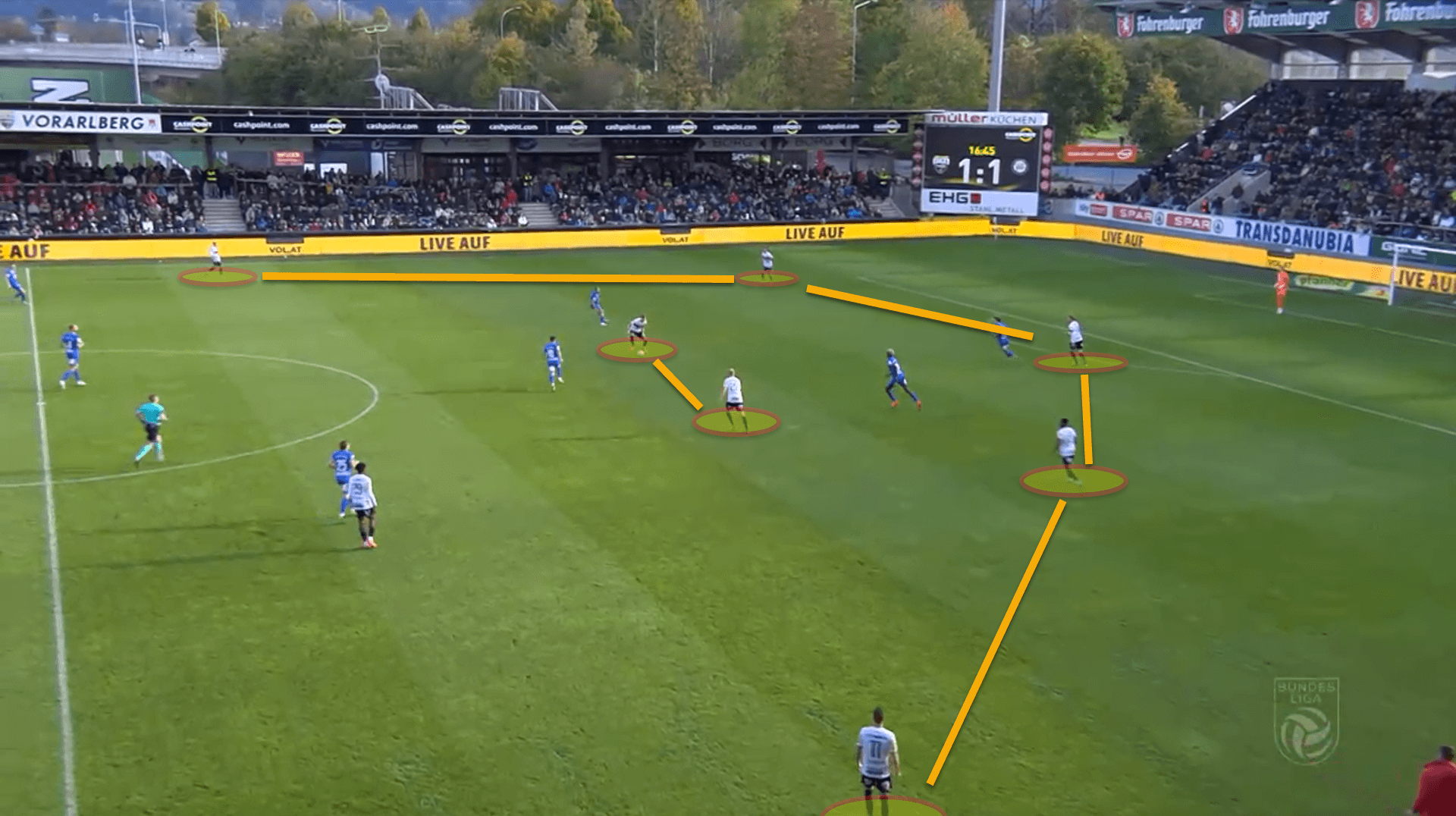
However, for the most part, Klose instructs his players to construct themselves in this manner in order to entice the other team to press them higher up the pitch.
There are two main ways to beat a high press. Either a team attempts to play through it, or else play over it. Rheindorf Altach primarily choose the latter.
By doing so, the opposition commit several bodies forward to press, meaning there are fewer to protect the backline from long balls.
Using Atdhe Nuhiu, who is 6”6”, SCR Altach aim to play long to the Kosovo international which can be seen from the side’s passing network from their most recent fixture against Austria Lustenau.
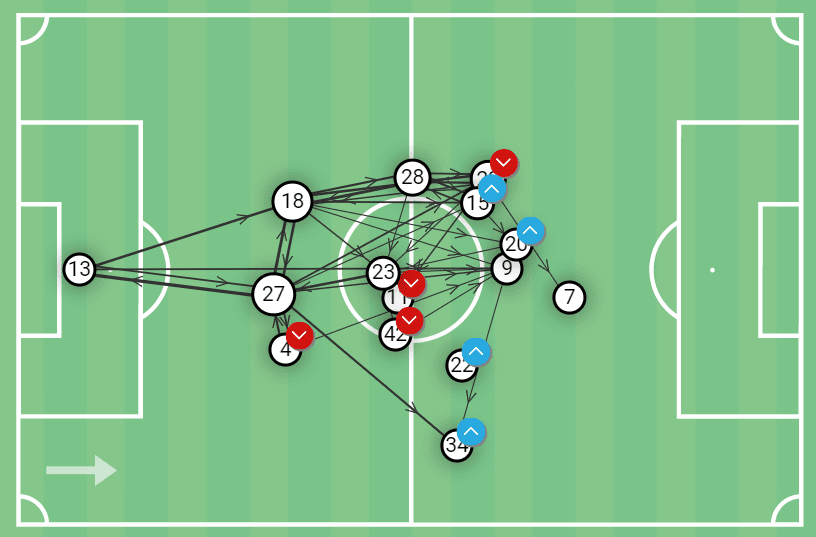
The ball from the goalkeeper to Nuhiu was one of the most used outlets for Klose’s team which is quite rare to see in the day and age of possession-based football.
Even the centre-backs, when under pressure, will play long to the big man or else to runners in behind in order to get in behind the opposition’s defence either through flick-ons or direct passes into space.
We can see this from Jan Zwischenbrugger’s pass map, who is Rheindorf Altach’s usual central centre-back of the three.
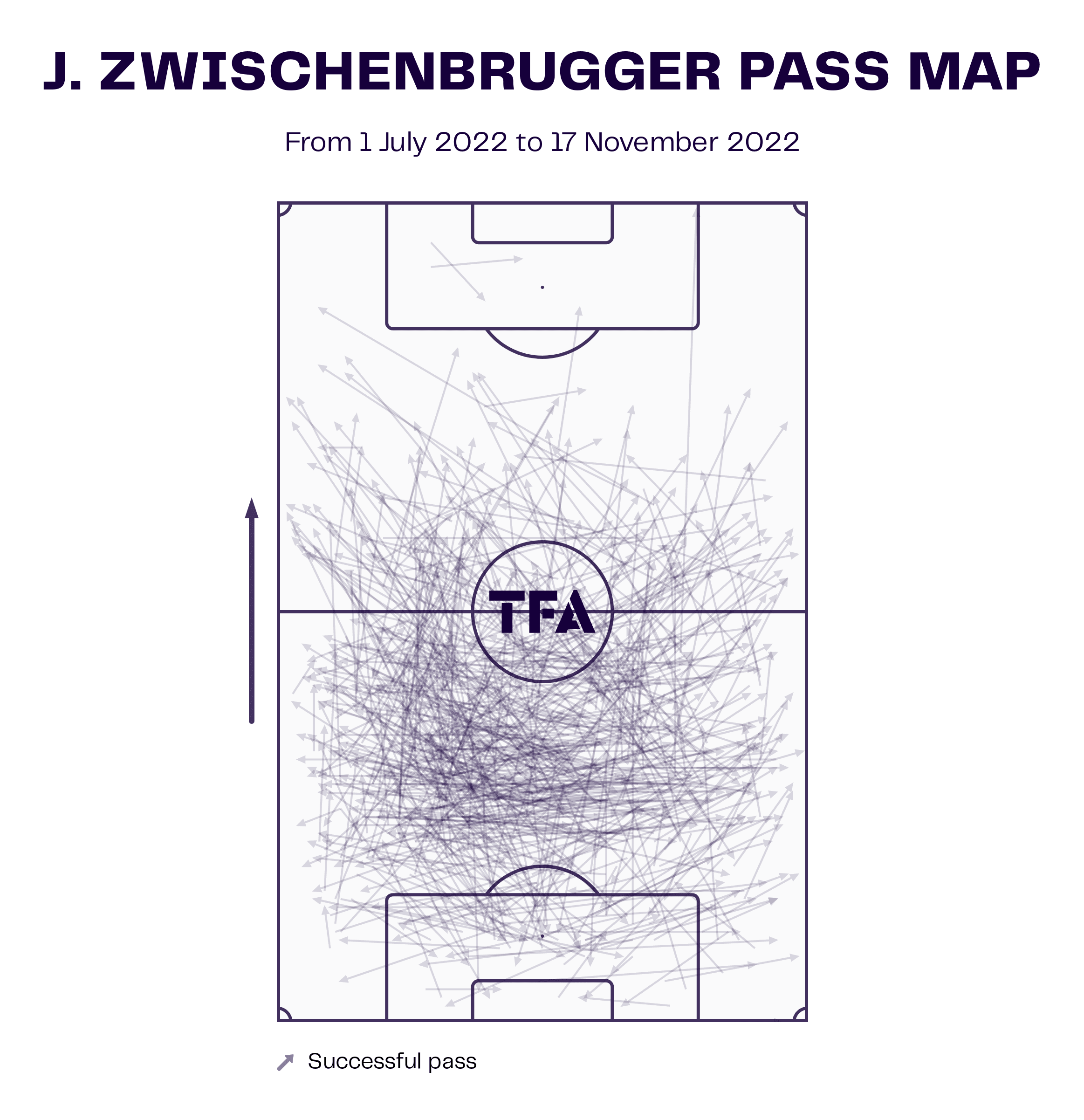
While a lot of his passes are square balls to his defensive partners and the goalkeeper, quite a lot are long balls to the frontline.
This is a useful tactic at times. Nuhiu is a handful for any defender. The Kosovan is strong, physically ginormous, excellent in the air and deft with the ball at his feet. From the following image, we can see Rheindorf Altach create a wonderful goalscoring opportunity using the target man’s strengths.
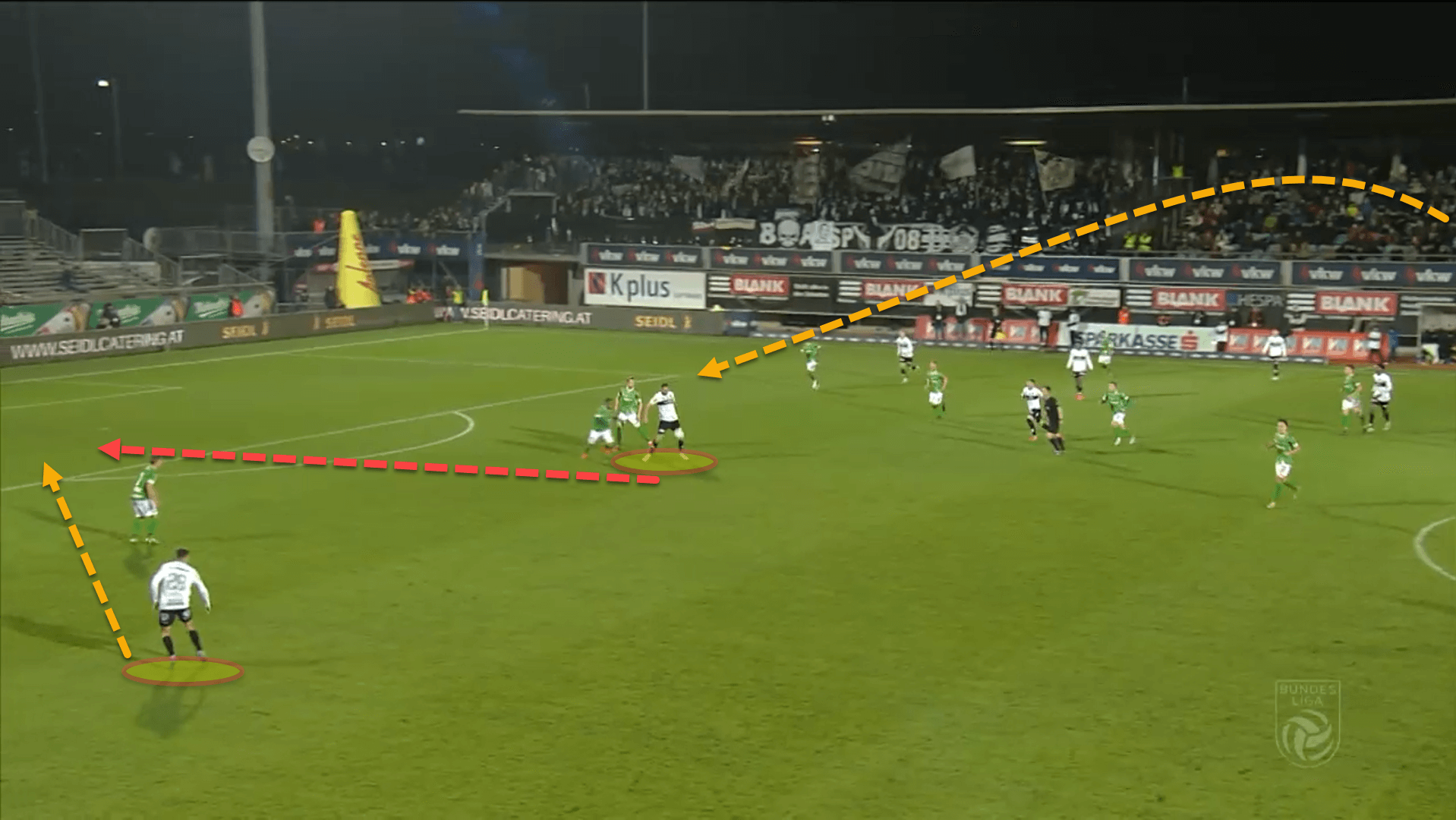
Nuhiu chested the ball down, and bullied his marker, shrugging him away to give himself time and space to turn and slip in the wide player who was running in behind. The chance was saved expertly by the goalkeeper but could have easily led to a goal.
Nonetheless, Klose is far too reliant on Nuhiu to progress into the final third. Quite often, the players don’t even bother to play it short, knowing that an easy route into the final third or penalty area is by passing it long to Nuhiu, regularly leading to a disconnect between the forward line and the midfielders.
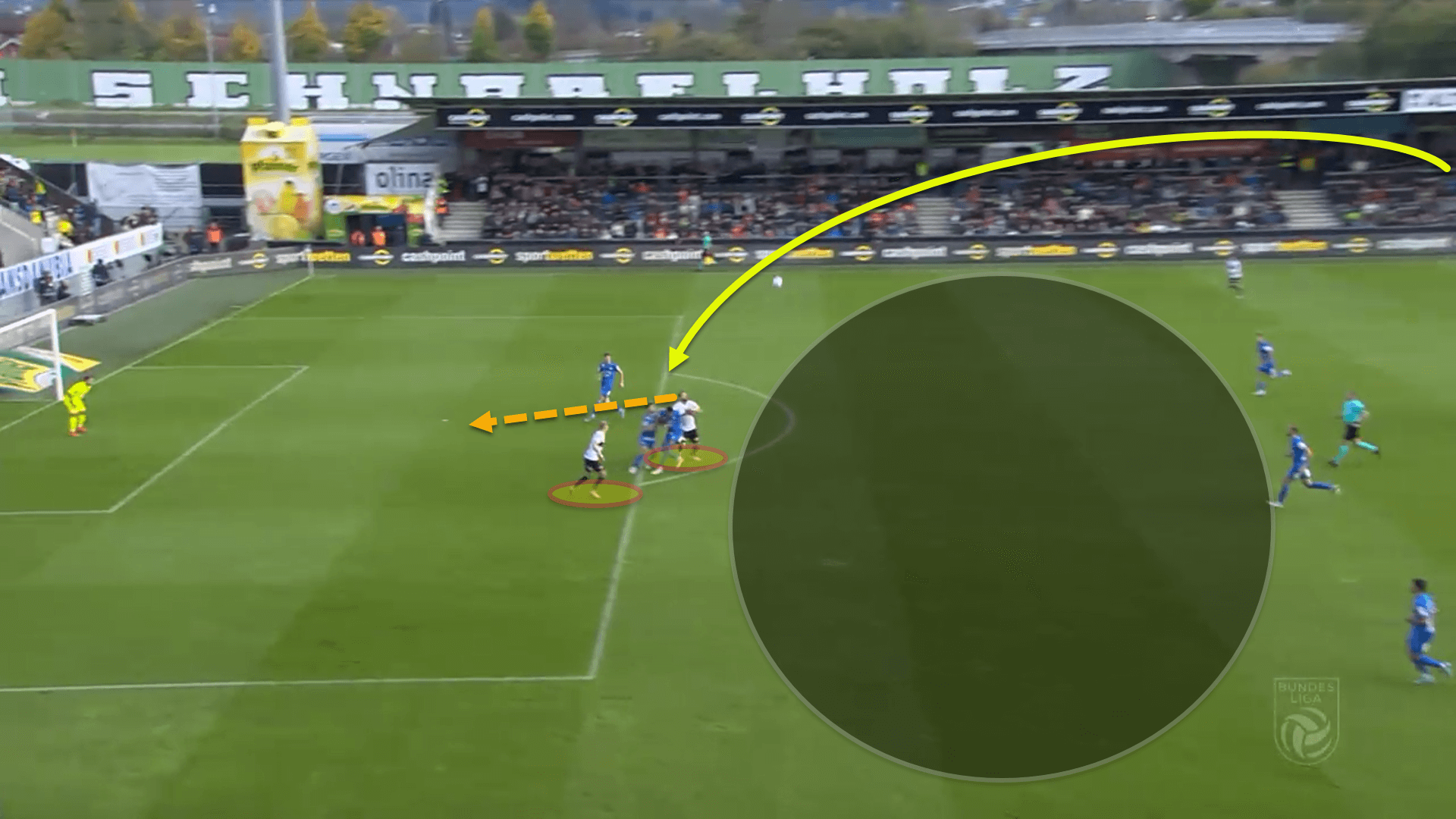
Here, the ball is pumped up to the centre-forward to win, either by taking it down under pressure or flicking it on with his head for his strike partner to latch onto.
But there is no support from the midfield who have been completely bypassed. Sturm Graz can recover the ball easily under no pressure, leading to wasted possession by Klose’s team.
The same issue comes to the forefront in the final third. Crosses are the main method used by SCR Altach to create chances on goal and Nuhiu is almost always the target, but this leads to a reliance on the large frontman to bag for the side.
Klose can still use Nuhiu’s aerial prowess to the side’s advantage but must experiment with ways to ensure that Rheindorf Altach aren’t as reliant on the behemoth to hold the ball up, bring others into the game and score goals for the team all at the same time.
Conclusion
Things aren’t going well for Klose. He is still a young coach and has only been in charge for a few months so it may be necessary that the club grant him more time to fully integrate his tactical plans.
However, Rheindorf Altach have not been hesitant to sack managers in recent years in hopes of staving off relegation back down to the second division. If Klose is to hang onto his position at the Stadion Schnabelholz, he will need to turn results around quickly or else the board will be forced to pull the trigger.






Comments